Targeting Chord Tones
Depending on the style of music, using a scale to create a solo is as much about the chords as it is the scale. Something like a typical blues solo will often be based mostly around the minor pentatonic scale combined with cliche licks and other commonly used ideas. Other music may require much more attention to chord tones, some genres or styles try to make more use of dissonance.
When we talk about scales, key and theory etc., the style and genre can change things entirely. There is no one size fits all approach and this is where a lot of scale talk can get confusing. This is something we should all be aware of. A scale isn’t just a bunch of notes available to be played randomly, and a lot of what we learn is style or genre specific – generally speaking anyway. This is where it gets difficult for amateurs and beginners because most teaching leads us to believe a solo is all about the scale, which leaves us with the impression that all styles are equal when it comes to theory and method – but they aren’t. Play a minor pentatonic scale over a major blues and it can sound great. Do the same thing over an easy listening pop song and it might sound terrible.
We have to learn the basic stuff before we can get to grips with the more complicated things. What we’ve been doing so far in this series of lessons is all quite slow and boring, but for good reason, we have to learn these things if we want to understand scales, how they apply, and make our solos sound more melodic or professional.
Something to remember here is that when we play chord progressions that stay strictly in key (which is what we have been doing so far), then each and every chord will only contain notes belonging to the key. In other words, if we’re in the key of C major, then every note of every chord in the key can be found in the C major scale.
For example a I-IV-V in the key of C major contains the chords C, F and G. These are the chords in the backing track we have been using so far. At the beginning of this article, we also heard a backing track with two extra chords, Dm and Em. We’ll get to that but we need to keep things as simple as possible for now to avoid information overload.
No matter how or where on the fretboard you play any of these chords, each chord note can be found within the scale. Collectively, the notes in the chords C, F and G, make up the entire C major scale.
We’ve already learned that some scale notes clash over some chords. This is often more noticeable when it happens on a chord change or if a note is left hanging for too long without being resolved. We could avoid this by making sure we only play chord tones, but that would become very boring.
What we need to do is learn where our chord tones (good notes) lie around a scale pattern so that we can target them more easily. Learning this across the entire fretboard takes a lot of time and practice so it’s best to break things down into small areas of the fretboard to make things more manageable. This is the quickest and best way to practise until you get the hang of it. Once you get the feel for this way of thinking and playing, your solos will start to sound a lot more together.
Here’s an example of how we can break things down into smaller parts to practise. Study the diagrams below for the chords C, F and G, and the C major scale all around the 8th fret.




And for now we’re only going to use the notes on the first four strings, which will end up looking like this. The diagrams show where the chord tones overlap the scale.




Example 19
First we’ll play through the chord tones only, something like this.
Example 20
Now just a bit of scale noodling with the four string C major scale pattern.
Example 21
This time we’ll solo with the scale but also pay attention to chord tones, especially on the chord changes.
There are many chord tones used throughout but the ones marked with T are where I was intentionally targeting them. Note that most of them are anticipated just before beat 1 of the chord change. Everything in between is just scale noodling and trying to use my ears.
Paying attention to the chord tones like this makes for a more melodic solo that fits the with the chords. It’s all still a bit boring but we need to know this stuff so that we can improve our fretboard knowledge.
To make things more interesting we can experiment and look for other ideas. We could try something like this: Use three consecutive notes of the scale starting from each chord root, i.e., C, D and E on the third string. F G and A on the seconds string and G, A, B on the second string.
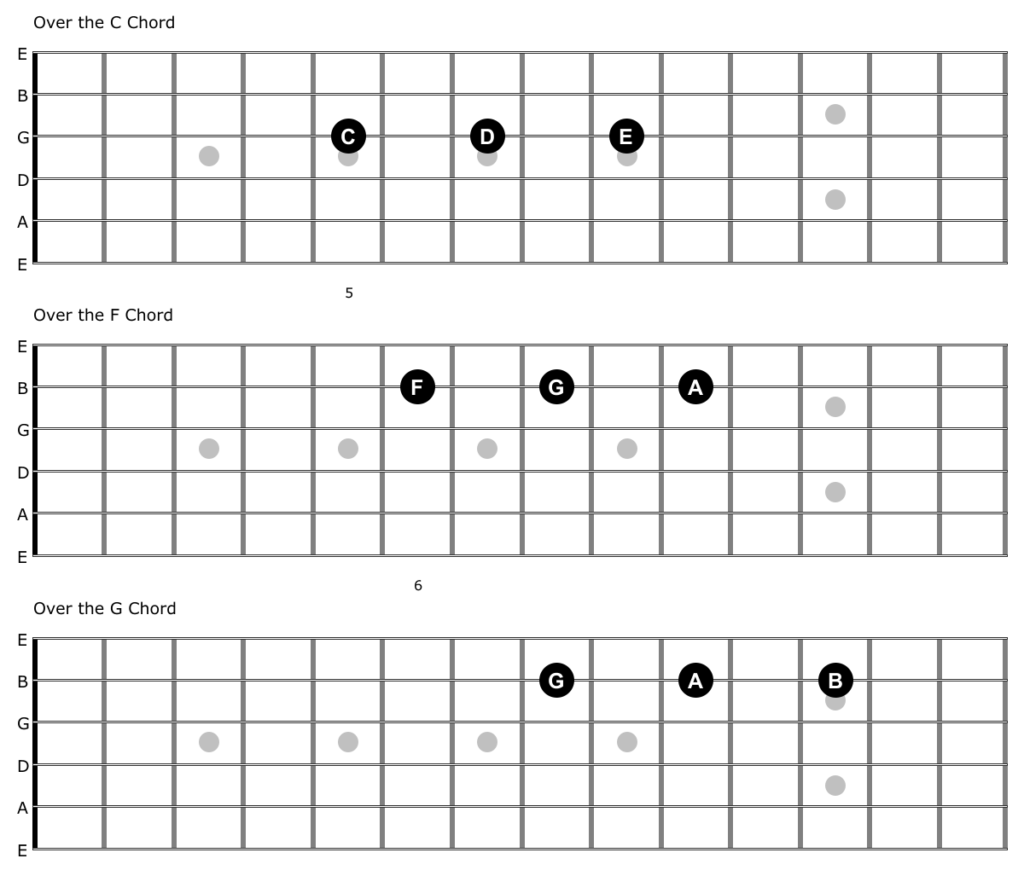
Example 22
First something very simple to get used to them.
Example 23
Same sort of thing but more melodic with some slides and vibrato.
Example 24
Again, here’s something similar. For the chord change in bar 5, I bend up a semitone to the F from the E at the ninth fret. In Bars 9 and 10 I’m not so much targeting a chord tone but messing around a bit with the root and 2nd, similar to the previous example but with just the root and 2nd instead of root, 2nd and 3rd.
More notes, More chords
Some of these ideas can seem boring but you need to practise these kinds of things regularly if you want to improve and get a better understanding of how scales are used for soloing. It’s all about building fretboard knowledge and training your ears. The more you do this, the better you will get at it.
Right, more chords, let’s get back to the other backing track.
In the first few examples of Part 1, we found that chord progressions with more regular chord changes tend to be more forgiving with random, or busier, scale note playing. The reason for this is the busier the backing, the more our ears can accept more dissonance, or at least to an extent. We have a kind of short term memory with audio. For example, if we play an F note over the C chord, it won’t normally sound too good – but if we’ve just changed from the F chord back to the C chord then this note won’t sound quite so harsh because we’ve just prepared our ears for it over the F chord. With that in mind, the more frequently the chords change, the more forgiving dissonant notes can be, as long as they aren’t sustained for too long.
This might help arbitrary scale playing sound better because we can get away with more. This doesn’t make our need to learn our way around the fretboard any less important. The more we get into the details and open up the fretboard, the better we will be as guitarists. When we mess around over a jam track, we should be experimenting and thinking about what we are doing. Admittedly, this might be harder for you if you can’t find the chords or notes quickly – but that is one of the reasons we keep the exercises somewhat simple. If you spend all your time flying all over the fretboard just using scale patterns, then you will get nowhere, fast.
How you practise these kinds of things is up to you to decide, but here I’ll show you an idea of how you could go about practising and experimenting.
First we look at the chords in the backing track, here they are again.

Now we’ll choose some positions for each chord and start by playing arpeggios just to help get used to where they are. It could be any chord position you want but I’m going to choose the ones shown in the following TAB.
Arpeggios over the chords
Example 25
Start by just playing through the chord shapes we are going to use here, maybe something like this. You can skip this if you already know these chord positions well enough.
Example 26
Now let’s break them down a bit and just use four strings. I’m just showing ideas here, mess around how you like, the goal is to really nail down and memorise where the chord tones are, but don’t use all six strings in the beginning or it will just be more to learn – get used to things in easy stages.
Example 27
And now less is more. We’re not really playing arpeggios here but we’re still using the previous exercises as a framework and just picking out notes from the chords.
Slowly keep breaking things down and experimenting with things in this way and then add new ideas as you go.
Example 28
Here I play around over the jam track and just keep going for 72 bars. Use this as an example of how to practise and experiment. I won’t mark out all the chord tones as this exercise is mostly chord tones throughout. I’ll include the chord diagrams over each change to make it easier to visualise what I’m trying to do.
1: First run through all of the chords just picking out the notes on the 2nd and 3rd string. I chose the 3rd and 4th string for the G but it doesn’t matter, we’re just experimenting.
2: Slight variation of the above. This time I quickly slide into the first note and repeat the second. Also switch the picking order from the F chord.
3: Now all one one string.
4: Another slight variation of the above
5: Now some sliding between notes, again staying on the third string.
6: Similar again but adding a hammer on / pull off with the first two notes.
7: Now a mix of short arpeggios and chord tones. Look at the notes I’m playing, it’s mostly all straight out of the underlying chords. It’s still very similar to the previous ideas but starting to sound more melodic. I’m slowly just building on ideas and mixing them up as I go.
8: Again another simple idea but this time I’m not always starting each chord change on the first beat and I’m leaving more space between phrases.
9: Just another mix up of ideas putting them all together.
You could go on for a while like this. Just run the backing track and keep going. Keep looking for the chord tones, experiment with the rhythm etc., and don’t be worried about messing up. What I did here was one take but I’d already spent a few minutes playing around before I hit the record button.
The exercise here is to build ideas in small steps, each one leading on to the next. You might be tempted to go a bit wild with it all, that’s OK sometimes but don’t forget that the point of this is to work on the ability to quickly and easily find the chord tones under your fingers. This takes a lot of practice so don’t expect any kind of overnight fretboard fluency.
OK, one more idea before moving on to the next topic on scales for blues soloing. We’ve already figured out that playing too many scale notes in succession, not only sounds like we’re just playing scales, but also creates a potential for more note clashes. Too few notes sound much better but obviously gets boring quickly. Chord tones sound great but if it’s all we do then that also becomes predictable and boring after a little while.
We haven’t really discussed the pentatonic scale much here, other than it gives us fewer notes to potentially cause clashes. Pentatonics generally sound good, we’re all very familiar with the sound they create because we hear them in popular music all the time. The only problem is they can lack some melodic choice when we’re really looking for a sweeter sound.
If however we take all what we’ve looked at so far and combine it with the pentatonic scale, we usually end up with something that sounds far more complete and adds some necessary sparkle.
Here’s the C major pentatonic scale that we’ll be using.
Example 29

Example 30
When we’re thinking only about the scale pattern, The common temptation is to play it something like this, basically noodling through the scale notes.
As expected, it just sounds like a pentatonic scale solo.
Example 31
Now let’s take a very simple idea using just a few scale notes.
Example 32
Now we’ll try mixing the two using a simple idea – I’ll do pretty much the same thing but replace bar 1 and bar 3 with some pentatonic phrases.
The bottom line with all of these kinds of exercises is you have to learn them and practise until you begin to hear and do things almost on autopilot. There is no short-cut, you have to keep on playing and experimenting and you will gradually build a virtual bag of ideas that you can pull things out from and try. It takes a lot of effort. Over time you should have a bunch of phrases and ideas built into muscle memory, it could be chord tones, major scale or pentatonic phrases and runs and rhythmic ideas that you can use and adapt to fit the style.
Add to that, we’ve not even looked much at the various techniques and articulations that you can also throw in to the mix for even more variety. There’s a lot to learn!
Example 33
One more example before we move on, here’s another take mixing things up with the major pentatonic.
Next, in Guitar Soloing Part 3, we’re going to ramp up the the overdrive slightly and get into some blues progressions.

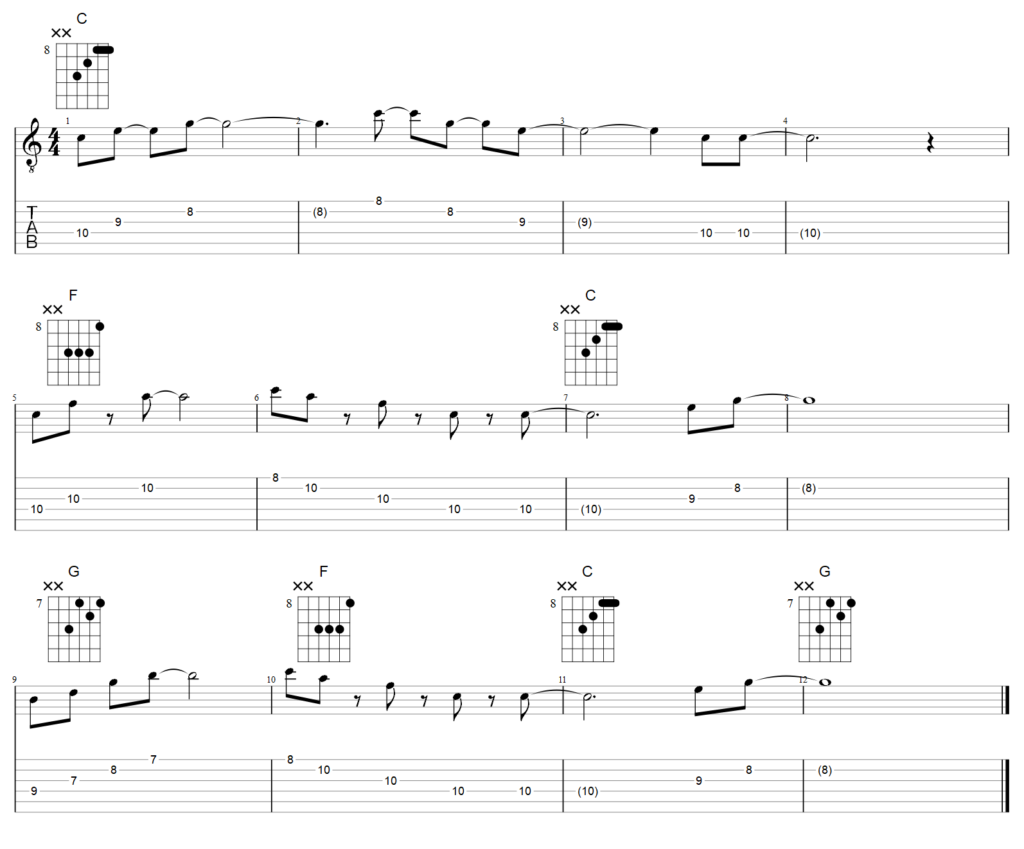
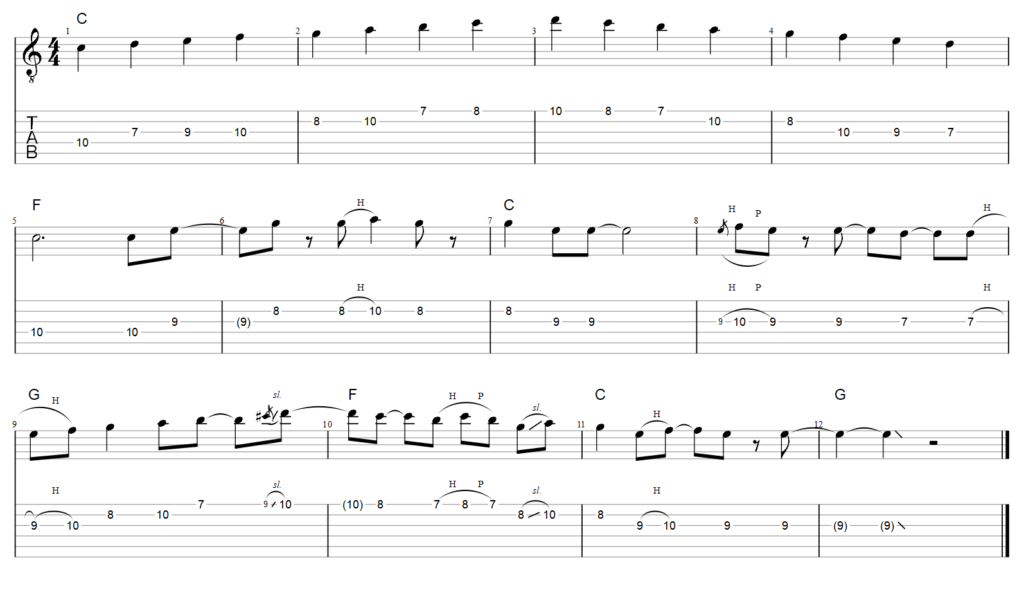
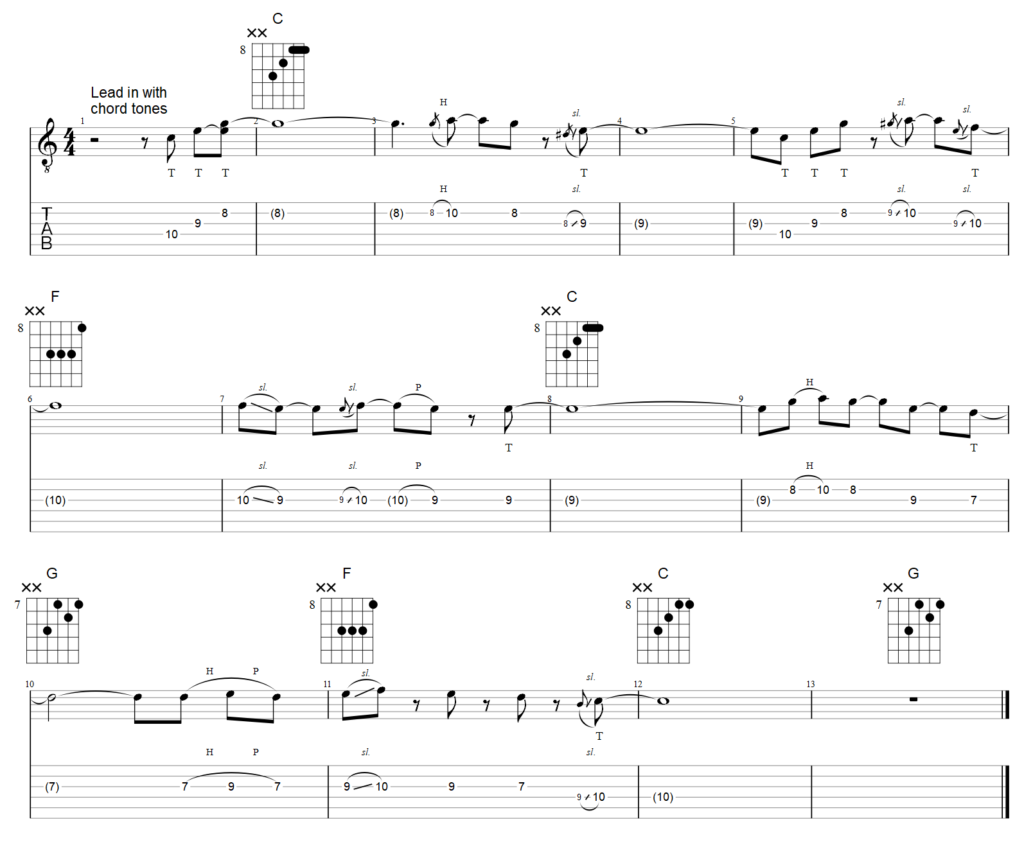
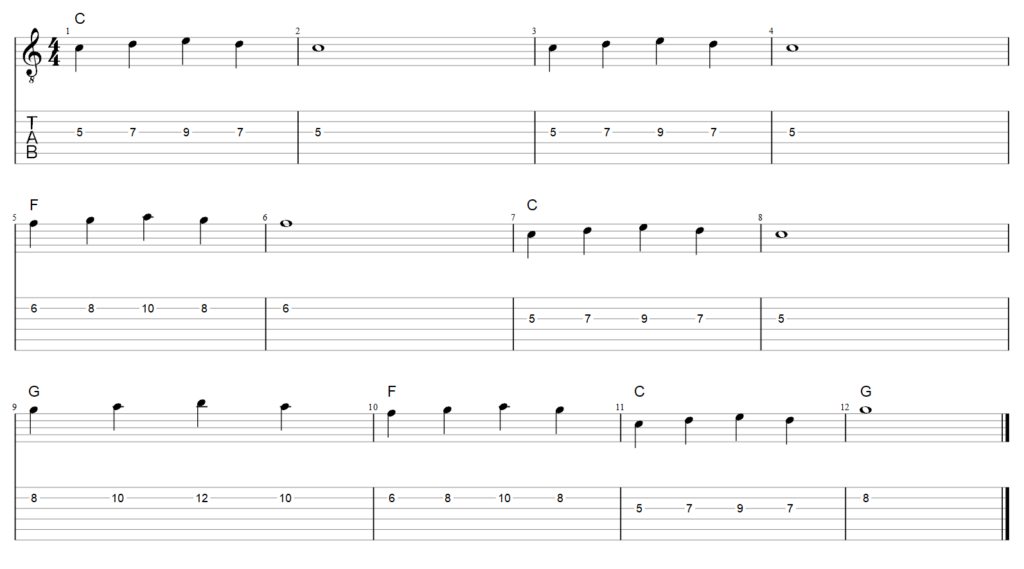
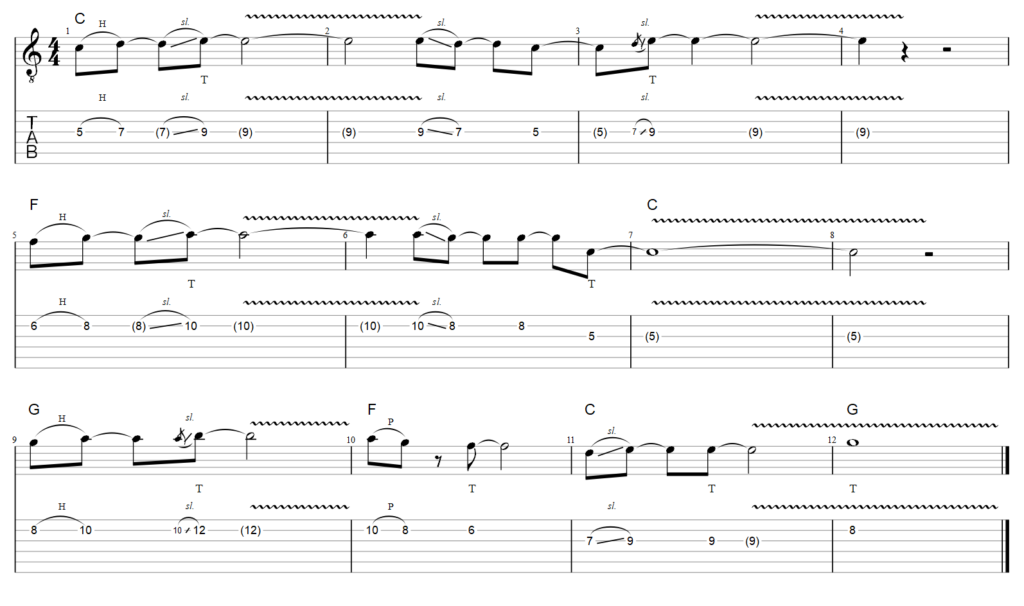
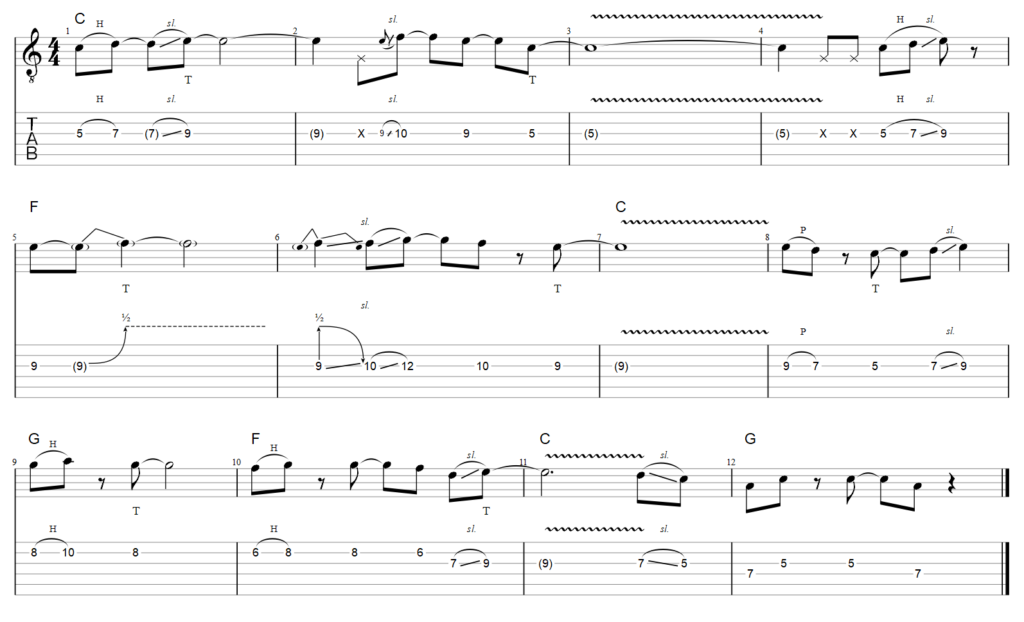
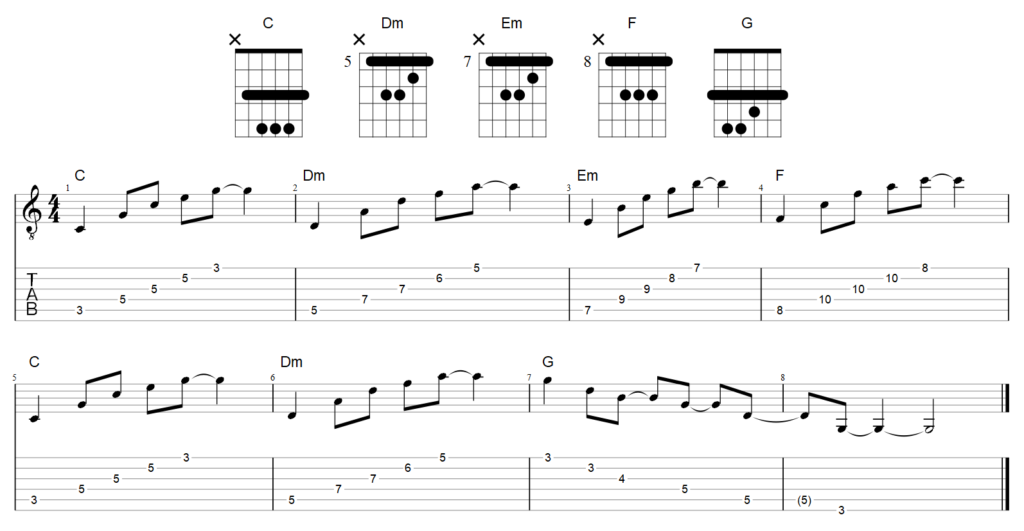
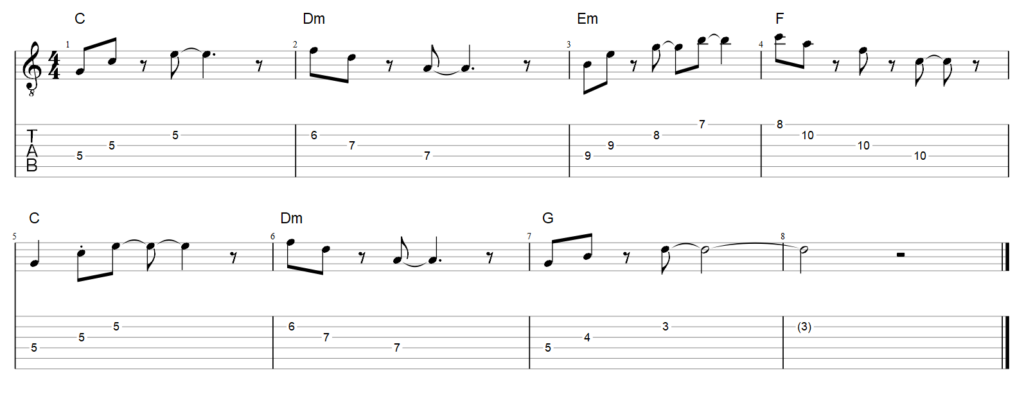
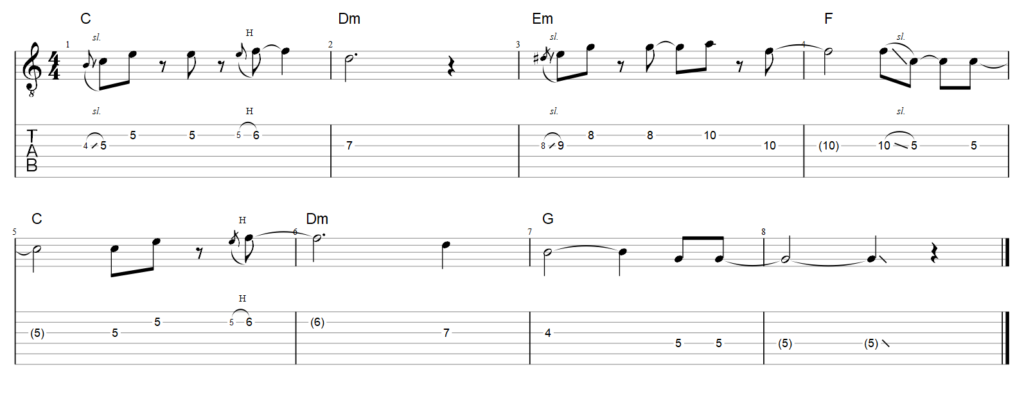
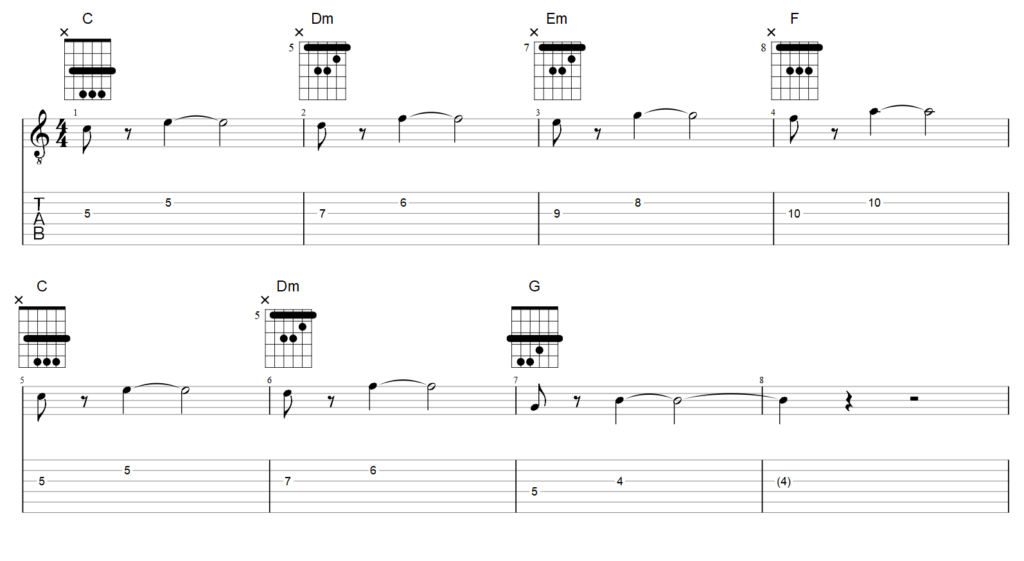
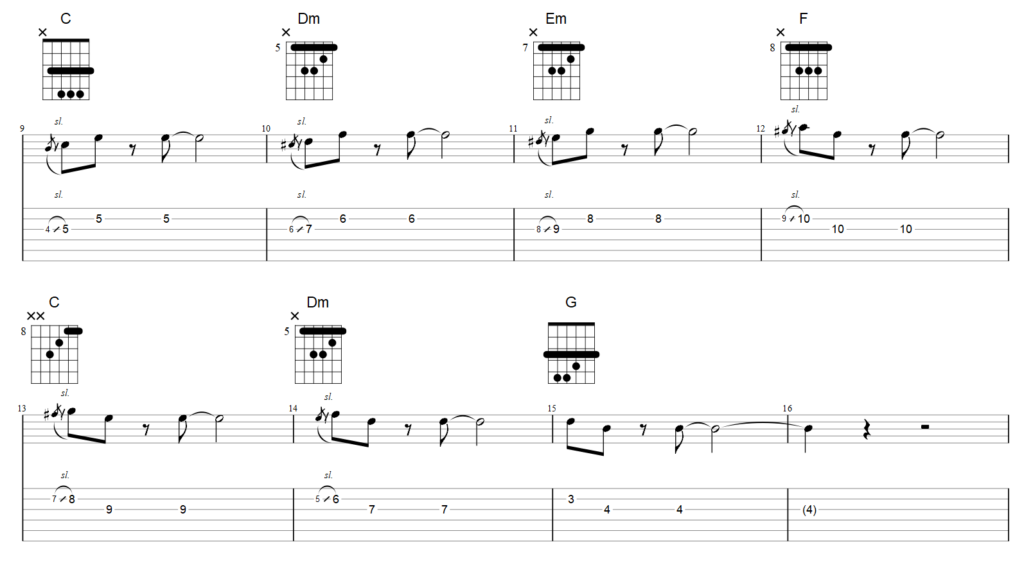
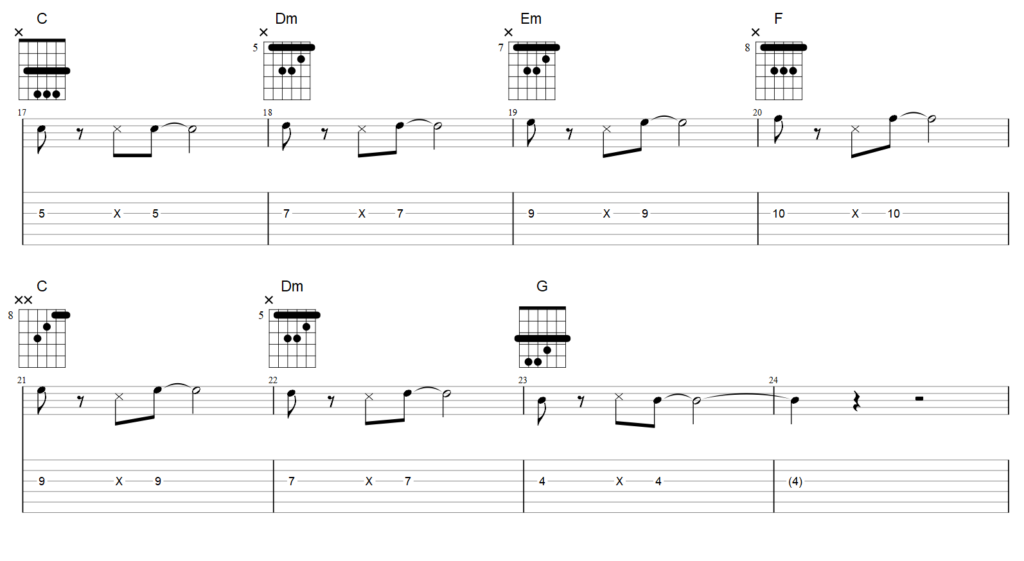
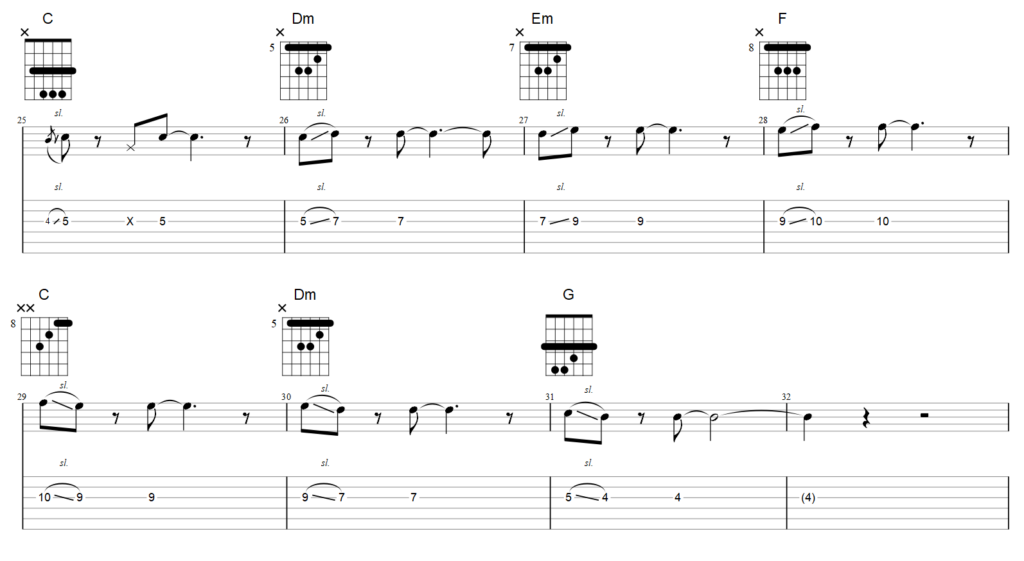
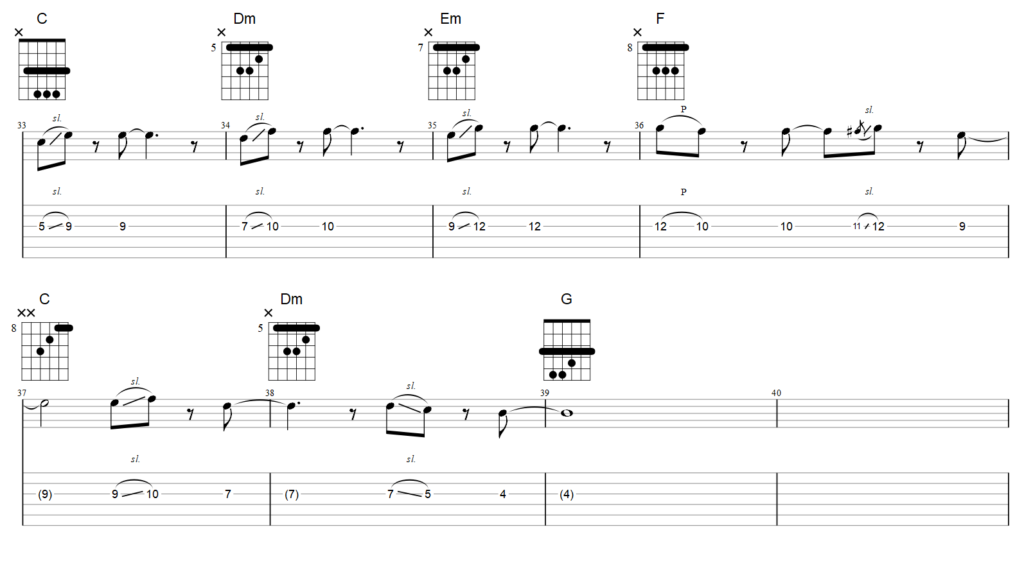
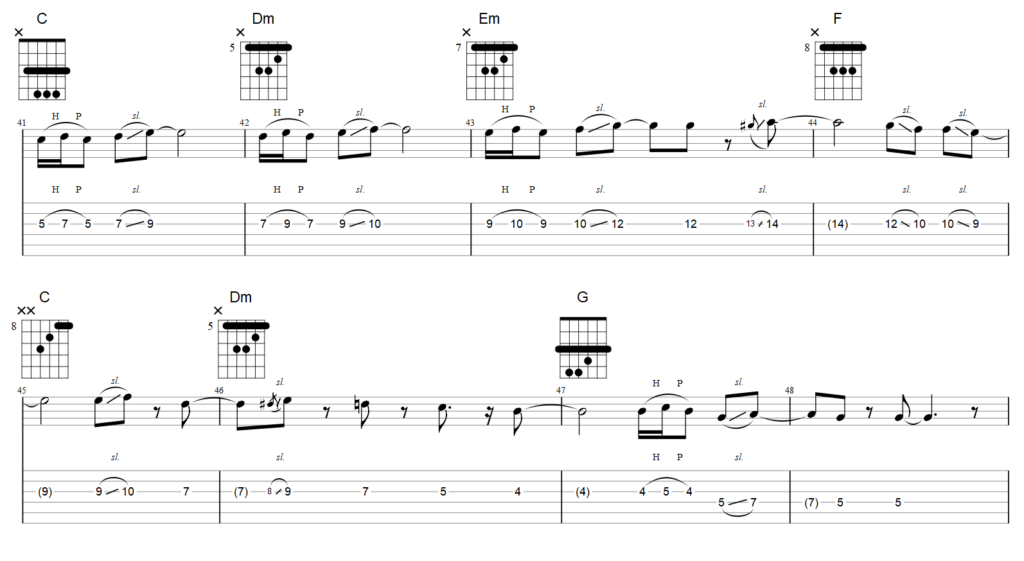
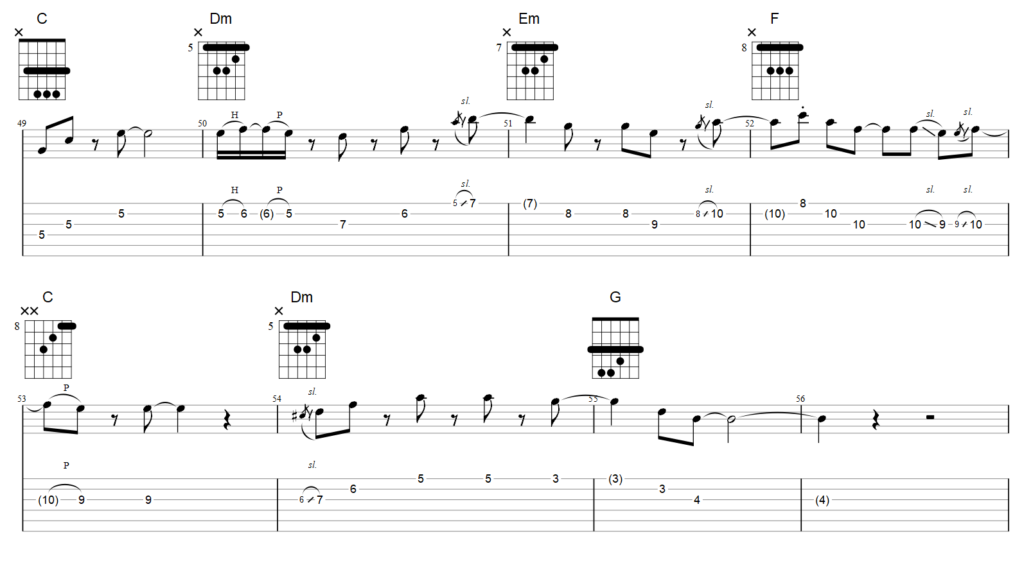
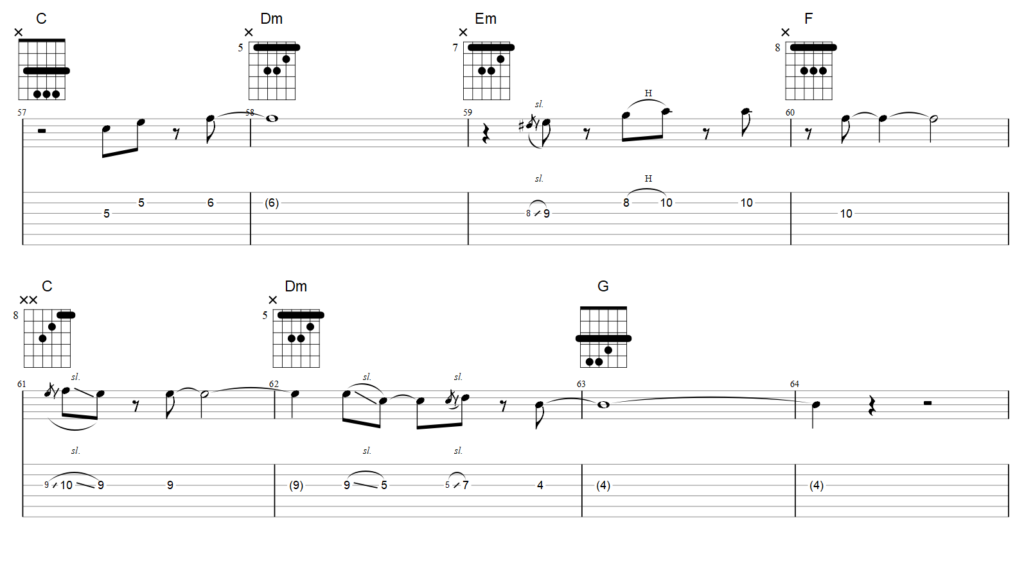
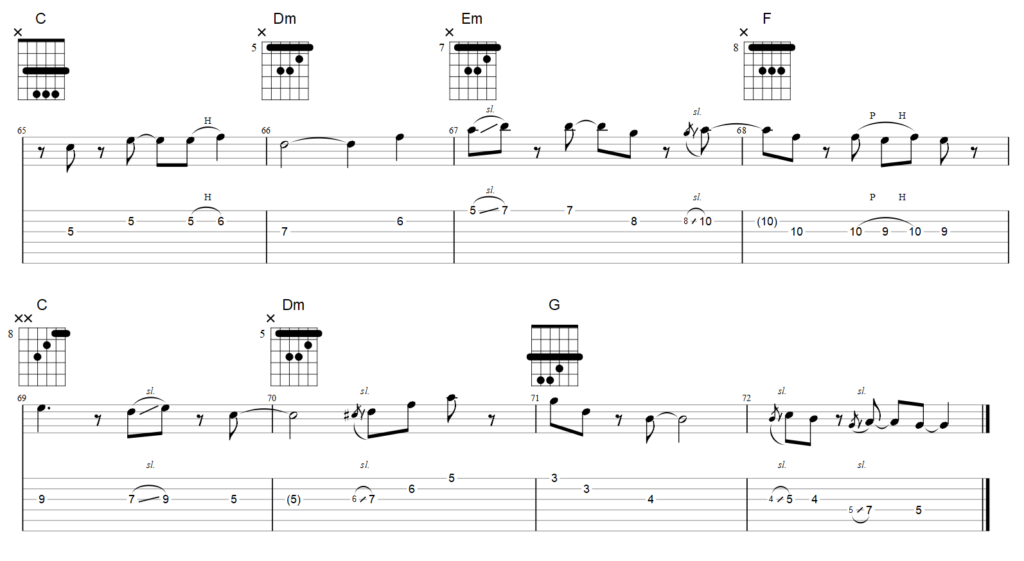

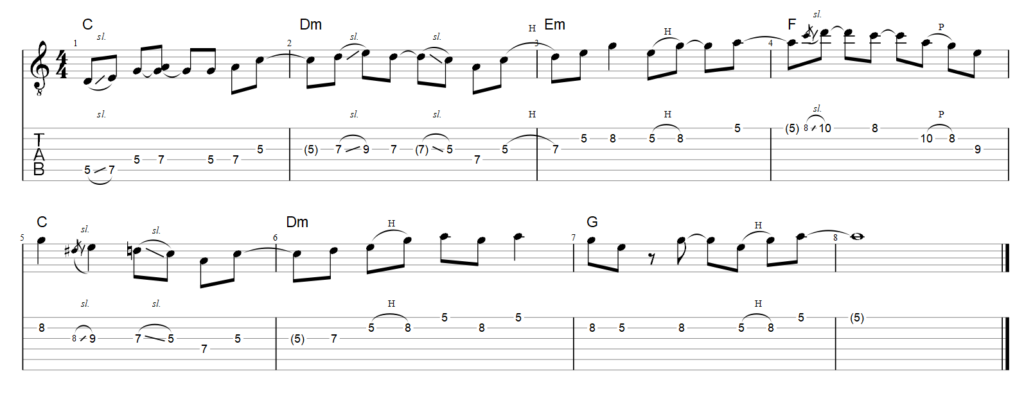


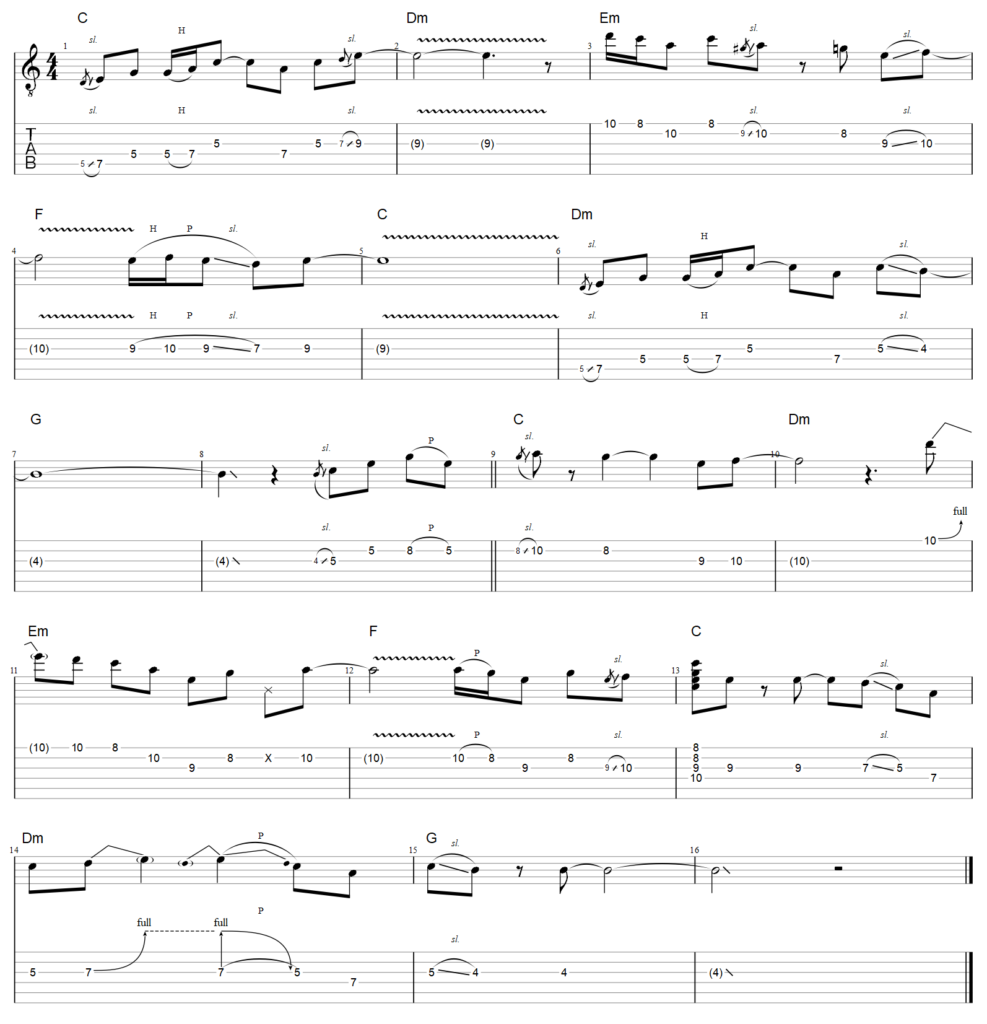
excellent series Lee .
Aaron
Thanks Aaron
Man Crystal clear Kudos for Lesson